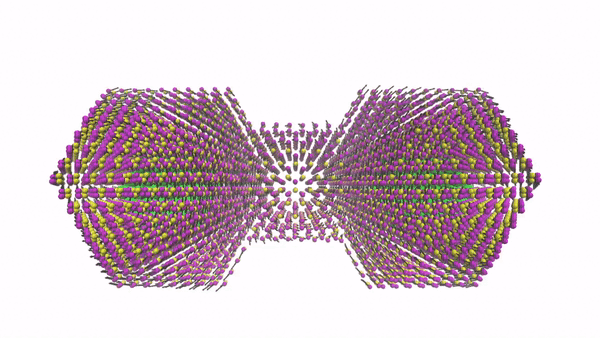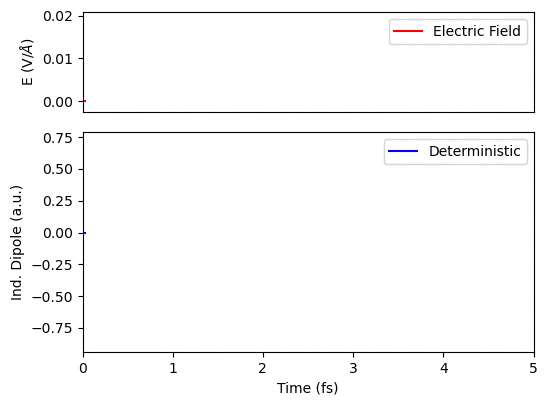Theoretical and Computational Nanoscience
Our Research
Optoelectronic Properties of Nanomaterials
The quantum confinement effect in nanoscale crystals unlocks size-tunable optical and electronic properties, affording numerous applications in biological sensing, renewable energy, and frontier devices. Theoretical approaches to understand and control the numerous exciting properties of nanocrystals (NCs) are limited by the challenge of accurately computing quantum systems of many thousands of atoms.
We develop models using stochastic electronic structure methods, semi-empirical pseudopotentials, and classical force fields to accurately describe the exciton fine structure, phonon modes, and exciton-phonon couplings of NCs. We are examining these systems in collaboration with experimentalists to understand the nature of charge carriers, fundamental photophysics, and quantum effects at the nanoscale.

Selected Publications:
D. Jasrasaria and E. Rabani. Circumventing the Phonon Bottleneck by Multiphonon-Mediated Hot Exciton Cooling at the Nanoscale. (2023).
D. Jasrasaria, D. Weinberg, J. P. Philbin, and E. Rabani. Perspective: Simulations of Nonradiative Processes in Semiconductor Nanocrystals. J. Chem. Phys. 157, 020901 (2022).
L. Verbitsky et al. Hybridization and Deconfinement in Colloidal Quantum Dot Molecules. J. Chem. Phys. 157, 134502 (2022)
J. P. Philbin and E. Rabani. Auger Recombination Lifetime Scaling for Type-I and Quasi-Type-II Core/Shell Quantum Dots. J. Phys. Chem. Lett. 11, 5132-5138 (2020).
Quasiparticle Dynamics
Electron transfer is the essential process that gives life energy, enables modern technology, and characterizes the structure of matter. We are interested in studying the diverse electron transfer properties in nanomaterials. Our methods may serve as a starting point for studying electron transport properties in QD arrays for quantum information processors or layers in photo-harvesting devices.
We are eager to take our expertise into regimes where traditional techniques are not adequate. Current efforts especially focus on how the interplay of lattice vibrations, light, and electrons affect the dynamics in complicated and experimentally relevant low dimensional materials. Our models aim to capture and explain dynamic optical and electronic phenomena for such strongly-coupled systems.

Selected Publications:
B. Hou et al. Nonadiabatic to Adiabatic Transition of Electron Transfer in Colloidal Quantum Dot Molecules. (2023).
A. Das et al. Tagged Particle Dynamics in Supercooled Quantum Liquids. Phys. Rev. E 105, 054136 (2022).
M. Enright et al. Role of Atomic Structure on Exciton Dynamics and Photoluminescence in NIR Emissive InAs/InP/ZnSe Quantum Dots. J. Phys. Chem. C 126, 7576-7587 (2022).
A. Levy, E. Rabani, and D. T. Limmer. Response Theory for Nonequilibrium Steady-States of Open Quantum Systems. Phys. Rev. Res. 3, 023252 (2021).
Stochastic Electronic Structure Methods
Understanding the fundamental physics and chemistry of molecules and materials requires high-level simulations of their geometry, electronic structure, and dynamics. However, the steep computational cost of modern quantum chemistry methods makes it challenging to perform simulations of systems relevant to current experiments and technological applications.
To tackle this problem, we have developed stochastic approaches to traditional methods in quantum chemistry that rely on cheaper stochastic estimations of the physical observables at the cost of introducing a small controllable error. This has led to the first-ever report of a sub-linear scaling electronic structure method. These developments allow us to compute ground-state and excited-state properties of molecules, nanostructures, and materials.

Selected Publications:
M. Chen, R. Baer, and E. Rabani. Structure Optimization with Stochastic Density Functional Theory. J. Chem. Phys. 158, 024111 (2023).
B. Shpiro et al. Forces From Stochastic Density Functional Theory Under Nonorthogonal Atom-Centered Basis Sets. J. Chem. Theory Comput. 18, 1458-1466 (2022).
M. Chen et al. Stochastic Density Functional Theory: Real- and Energy-Space Fragmentation for Noise Reduction. J. Chem. Phys. 154, 204108 (2021).
W. Dou et al. Range-Separated Stochastic Resolution of Identity: Formulation and Application to Second Order Green's Function Theory. J. Chem. Phys. 153, 074113 (2020).


